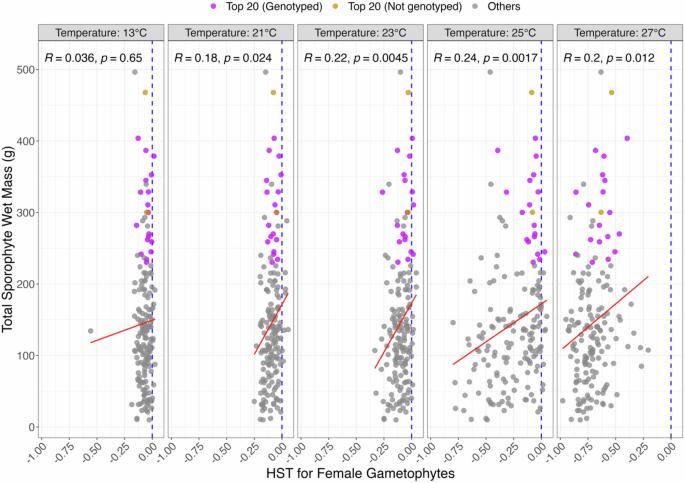Heat stress analysis suggests a genetic basis for tolerance in Macrocystis pyrifera across developmental stages
IF 5.2
1区 生物学
Q1 BIOLOGY
引用次数: 0
Abstract
Kelps are vital for marine ecosystems, yet the genetic diversity underlying their capacity to adapt to climate change remains unknown. In this study, we focused on the kelp Macrocystis pyrifera a species critical to coastal habitats. We developed a protocol to evaluate heat stress response in 204 Macrocystis pyrifera genotypes subjected to heat stress treatments ranging from 21 °C to 27 °C. Here we show that haploid gametophytes exhibiting a heat-stress tolerant (HST) phenotype also produced greater biomass as genetically similar diploid sporophytes in a warm-water ocean farm. HST was measured as chlorophyll autofluorescence per genotype, presented here as fluorescent intensity values. This correlation suggests a predictive relationship between the growth performance of the early microscopic gametophyte stage HST and the later macroscopic sporophyte stage, indicating the potential for selecting resilient kelp strains under warmer ocean temperatures. However, HST kelps showed reduced genetic variation, underscoring the importance of integrating heat tolerance genes into a broader genetic pool to maintain the adaptability of kelp populations in the face of climate change. 204 Macrocystis pyrifera genotypes were screened and a panel of heat-stress tolerant (HST) gametophytes were identified. A subsequent analysis revealed a correlation between the HST strains and increased sporophyte biomass under warmer ocean conditions.

热胁迫分析表明了巨藻各发育阶段耐受性的遗传基础
海带对海洋生态系统至关重要,但其适应气候变化能力的遗传多样性仍然未知。在这项研究中,我们重点研究了对沿海栖息地至关重要的海带--Macrocystis pyrifera。我们制定了一套方案,评估 204 种海带基因型在 21 ℃ 至 27 ℃ 热胁迫处理下的热胁迫反应。我们在此表明,在温水海洋养殖场中,表现出热胁迫耐受(HST)表型的单倍体配子体与基因相似的二倍体孢子体一样,也能产生更大的生物量。HST 以每个基因型的叶绿素自发荧光来衡量,此处以荧光强度值表示。这种相关性表明,早期微观配子体阶段的 HST 与后期宏观孢子体阶段的生长性能之间存在着预测关系,这表明在海洋温度较高的情况下,有可能选育出抗逆性强的海带品系。然而,HST 海带的遗传变异减少,这突出了将耐热基因整合到更广泛的基因库中以保持海带种群在气候变化下的适应性的重要性。筛选了 204 个海带基因型,确定了耐热配子体。随后的分析表明,在较暖的海洋条件下,HST 菌株与孢子体生物量增加之间存在相关性。
本文章由计算机程序翻译,如有差异,请以英文原文为准。
求助全文
约1分钟内获得全文
求助全文
来源期刊

Communications Biology
Medicine-Medicine (miscellaneous)
CiteScore
8.60
自引率
1.70%
发文量
1233
审稿时长
13 weeks
期刊介绍:
Communications Biology is an open access journal from Nature Research publishing high-quality research, reviews and commentary in all areas of the biological sciences. Research papers published by the journal represent significant advances bringing new biological insight to a specialized area of research.
 求助内容:
求助内容: 应助结果提醒方式:
应助结果提醒方式:


